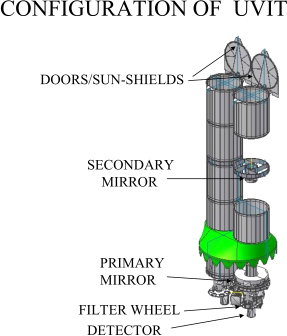The UltraViolet Imaging Telescope (UVIT):
The UltraViolet Imaging Telescope will perform imaging simultaneously in three channels: 130-180 nm, 180-300 nm, and 320-530 nm. The field of view is a circle of ~ 28 arcmin diameter and the angular resolution is 1.8" for the ultraviolet channels and 2.5" for the visible channel. In each of the three channels a spectral band can be selected through a set of filters mounted on a wheel; in addition, for the two ultraviolet channels a grating can be selected in the wheel to do slit-less spectroscopy with a resolution of ~ 100.

The configuration of UVIT on board ASTROSAT
The instrument is configured as two telescopes: one is for the FUV (130-180 nm) channel, and the other is for simultaneous imaging in the NUV (180-300 nm) & VIS (320-530 nm) channels. Each of the two telescopes is a f/12 Ritchey-Chretien combination with a primary mirror of ~380 mm diameter and a plate scale of ~ 24 micron per arcsec.
All the three channels use MCP-based intensified CMOS imaging detectors for recording images in either (high gain) photon counting mode or in (low gain) integrating mode in which individual photons cannot be distinguished. Typically, photon counting mode is used for the two ultraviolet channels which have a small flux, and integration mode is used for the VIS channel which has a high flux. Special attention has been paid to minimize the photo-cathode/MCP gap to get a spatial resolution of ~ 25 micron FWHM, i.e. ~ 1" on the plate scale of the telescopes, in the photon counting mode.
The ultraviolet images are typically taken at ~ 30 frames/s; for specific observations, depending on the size of the selected field, images of a partial field can be taken up to a rate of 200 frames/s. The time of each frame can be tracked to an absolute accuracy of 5 ms.
The effective area of the telescope depends on the chosen channel and the filter: it is ~ 15 sq cm for the FUV channel which only use crystal filters, and it is in range 15-40 sq cm for the various filters in NUV & VIS channels.
Click to use the current version of the UVIT Exposure Time Calculator